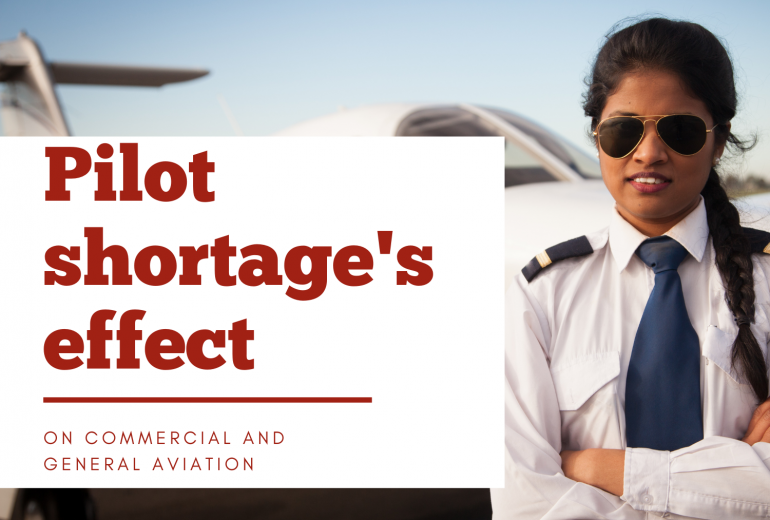We’ve all heard about the pilot shortage, but what’s causing it, and what effects can we expect on both commercial and general aviation?
Causes of the Pilot Shortage
The Federal Aviation Administration's (FAA) requirements that first officers accumulate 1500 hours of flight time, airline early retirement policies, and the pandemic's aftermath have all had a negative effect on the number of available pilots. In training new pilots, airlines must also ensure safety. Cutting down the required number of flight time hours could potentially put that safety at risk. And the cost to become a pilot isn’t cheap either. With rising gas prices, one flight school estimates it cost around $100,000.
How Commercial Aviation is affected?
In addition to the impact of delayed or canceled flights for passengers, the pilot shortage has a number of major impacts on airlines themselves. A few notes about how the pilot shortage and overall economic condition has affected commercial aviation:
- Although post-pandemic air passenger demand has rebounded, commercial airlines are unable to benefit due to pilot shortage.
- At a time when airlines are unable to maintain adequate flights due to the pilot shortage, their expenses of leasing and maintaining aircraft facilities has increased. Higher expenses with lower revenue makes for a difficult financial situation.
- Because the vast majority of airlines are publicly labelled businesses, declining revenues, rising relative operating expenses, and in certain cases, net losses, have had a profoundly detrimental effect on the stock prices and business value.
- Numerous pilots sought early retirement benefits during the epidemic, and fewer people entered the field as a result of interruptions to pilot training programs creating a huge supply and demand gap.
General Aviation Facing Pilot Shortage
The general aviation sector continues to grow and lure passengers with cutting-edge service. Despite the Coronavirus outbreak, the general aviation industry increased when commercial airlines stopped or reduced flights.
Covid19 encouraged people to chose private travel to avoid large gatherings and save time. General aviation also helped people in emergency situations during Covid19 which allowed it to grow while commercial aviation stalled. Technological advancement is the primary driver of this increase, and the recent introduction of numerous new aircraft models has elevated demand to previously unheard-of levels.
However, as the lockdowns and restrictions are being removed across the world, people still choose to fly through general aviation for a number of reasons.
1- People are more safety-concerned now
2- Flying private with general aviation enhanced the corporate image of businesses
3- General aviation provides flights at short-notice which attracts more people
4- General aviation proved to be a life-saver in emergency situations
As the industry is growing, a lack of pilots poses a threat to the expansion of this upscale industry. Even still, the general aviation market may face difficulties in the future despite the influx of orders. Pilot shortages are anticipated in the business as pilots choose to pilot commercial airplanes rather than private employers, where pay can be better and work is frequently more reliable.
How GA is affected by the Pilot Shortage
By 2038, the aviation industry would need to hire an extra 98,000 pilots to meet the rising demand for air travel, per research by jet resale company Colibri Aircraft. If those numbers can't be obtained, the general aviation market will suffer the most.
Commercial airline pilots can benefit from higher pay and more predictable work schedules because they transport a far greater number of passengers. GA pilots, on the other hand, are at the whims of the owners of the aircraft and may find themselves out of a job should the aircraft be sold.
The general aviation industry finds it difficult to compete against airline companies in the pilot hiring industry. This indicates that commercial airlines have their pick of freshly trained pilots in addition to hiring current business aviation pilots.
To ensure sufficient talent is fostered and inspired to accept private sector jobs, private carriers may need to collaborate more extensively with commercial airlines.
General Aviation Role in Coping the Pilot Shortage
The key to training new pilots could lie with the general aviation industry. Pilots often start their training at flight schools and instructors housed at general aviation airports. This increases the importance of safeguarding local airports where flight schools teach, ensuring that sufficient talent, as well as experience, is preserved at the instructor stage, maintaining the flying clubs and social networks linked to airports, and involving the community in what happens at their local airport so that they are connected and aware of the crucial role of their airport in solving the pilot shortage.


